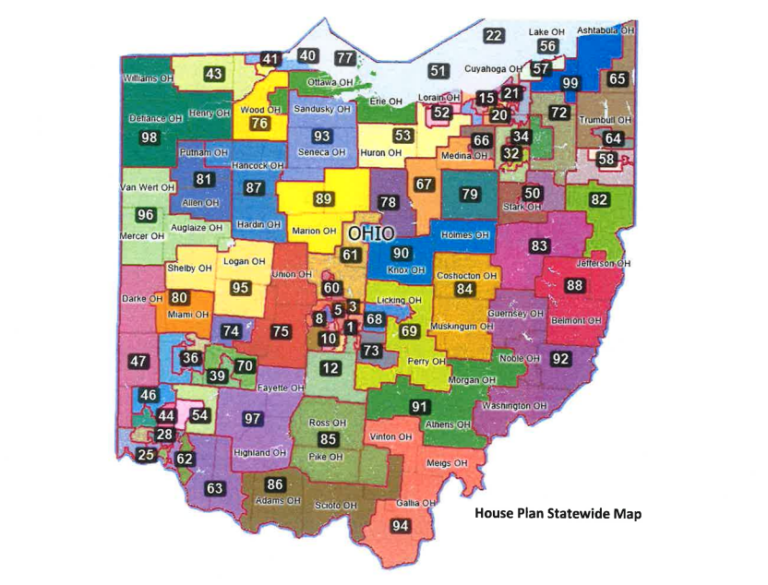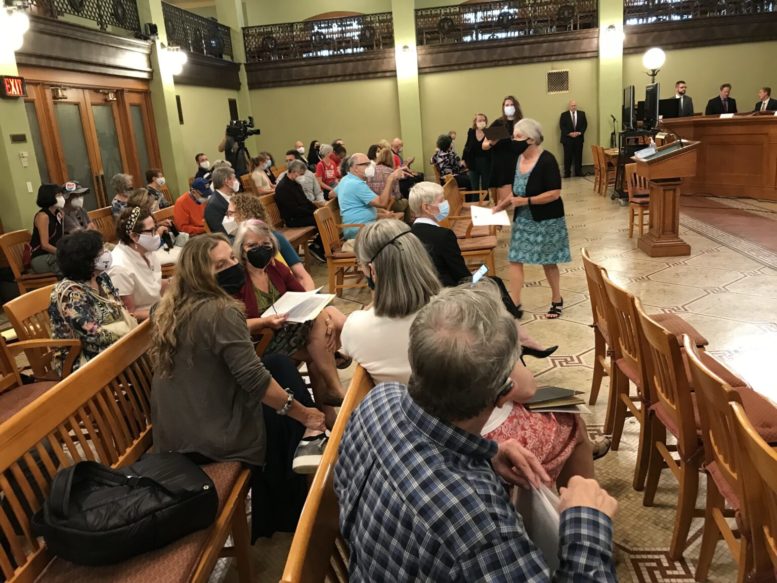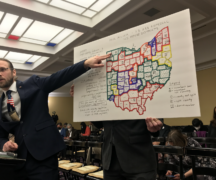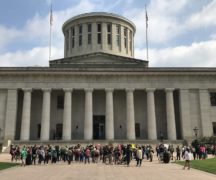BY SUSAN TEBBEN
In a matter of a few hours, Ohio Republican leaders had introduced their proposal for legislative districts in the state, and that map had been accepted as a “working document” by the majority-Republican Ohio Redistricting Commission.
Members of the GOP caucus, including staffer Ray DiRossi, who presented the Republican maps, blamed the lateness of census data on the delay in getting the maps together, but said their map was constitutional, and addressed population increases and losses in different regions of the state.
“The plan that we are presenting today fully complies with the requirements imposed by the state constitution,” DiRossi told the commission on Thursday morning.
What was not addressed within the GOP maps was demographic and racial data within the census, something DiRossi said was left out deliberately, and at the direction of “legislative leaders.”
“We did not use demographic data or racial data in the production of our maps,” DiRossi said, and when asked why, he said “we were directed not to use that data by legislative leaders, and so we did not use it.”
Commission co-chair also took issue with the lack of consideration the GOP map gave to election results as part of the district-drawing. DiRossi continued to say the maps presented on Thursday were constitutional, but said election data is still being studied.
“We are conducting an analysis of the election data contemplated by the constitution, that analysis is ongoing, it is not complete as of today,” DiRossi said.
Outrage over the rushed timeline was reiterated in public comments made during both redistricting commission hearings.
“I’m disappointed that we saw maps this morning that were obviously ready, with AV equipment and print-outs that were not submitted online for input,” said Dr. Tommie Radd, of Gahanna.
The maps drawn by the GOP also take out at least one Democratic legislator, and state Rep. Jessica Miranda, D-Forest Park, took to Twitter to object.

“Not only have the R’s drawn me out of my own district, but they think Forest Park, a majority minority city, and third largest city in (Hamilton County), should be lumped in with a majority rural district,” Miranda wrote on Thursday. “How is this okay? This isn’t democracy. It’s a rigged game.”
Jen Miller, executive director of the Ohio chapter of the League of Women Voters, said the redistricting process so far “doesn’t really pass the smell test,” and missed deadlines and a lack of maps didn’t help the public get behind the commission.
“It’s hard, I think, from the outside to feel trust in this process because of the lack of clarity, because of the lack of preparation,” Miller said.Ohio Redistricting Commission Public Meeting Schedule
- Sunday, Sept. 12, 4 p.m.: Washington Township Recreation Center, Dayton
- Monday, Sept. 13, 4 p.m.: Corporate College East, Warrensville Heights
- Tuesday, Sept. 14, 10 a.m.: Ohio House Finance Hearing Room, Ohio Statehouse
- This meeting will also include remote testimony from Washington State Community College in Marietta
Nevertheless, by the end of the day, the GOP maps had been passed through the commission on a 5-2 voter (with both Democrats voting against the measure), with the caveat that staff would be working together to compromise on a map that had bipartisan support.
“I’m optimistic… that we can have substantial negotiations, substantial conversations, to get to a 10-year map,” said Senate president and commission member Matt Huffman, whose name is on the GOP maps posted to the Ohio Redistricting Commission website.
Senate Democrats submitted their own proposal for legislative maps at the end of August, right before the initial Sept. 1 deadline was set to expire.
Along with Huffman, state auditor Keith Faber and Secretary of State Frank LaRose both offered up their staffs to work through the weekend on map negotiations before the first public meeting on Sunday.
“I think that now is when that real collaborative process can get started,” LaRose said.
Under the constitutional mandate, the commission must have at least three hearings after agreeing on a map, then they must have bipartisan support to pass 10-year maps. If they can only come to agreement with the majority Republican members, a four-year map will be passed.
The next official meeting of the Ohio Redistricting Commission was scheduled during the Thursday meeting, for the deadline date of Sept. 15. The commission will meet at 10 a.m. that day in the House Finance Hearing Room.
***
Also from Ohio Capital Journal:
Ohio leaders push to make it harder for poor to get health coverage
Ohio Gov. Mike DeWine has cast a skeptical eye on regulations for a group the state refers to as “job creators.” But he and Attorney General Dave Yost are pushing for regulations that will make it more difficult for the poor — including those with jobs — to get health care.
DeWine on Thursday announced that he was calling on Yost to sue to overturn President Joe Biden’s decision to invalidate Medicaid work requirements. Former President Donald Trump approved the Ohio work requirement in 2019.
In the Buckeye State, Medicaid covers 25% of the population, so the requirement would affect many.
“Removing a provision that says a healthy, able-bodied individual should be working, looking for work, participating in job training, or participating in a recovery program in order to receive free taxpayer-funded health care is contrary to Ohioans’ values,” DeWine said in a statement that was issued under his and Yost’s names.
It adds, “Eliminating reasonable requirements discourages people from becoming self-sufficient and only reinforces government dependency. Ohio’s program would offer assistance when Ohioans need it, while providing opportunities for future success.” READ MORE
NAACP, Democrats file lawsuit over new “stand your ground” law
Two Democratic lawmakers and the NAACP filed a lawsuit Thursday seeking to overturn a recently passed “stand your ground” law, which removes Ohioans’ legal duty to try to retreat before responding to a perceived attack with deadly force.
The legislation passed in the dying hours of the previous General Assembly often known as the “lame duck” session — the period after biennial elections but before the victors take office. (State Sen Theresa Gavarone, R-Bowling Green, and State Rep. Haraz Ghanbari, R-Perrysburg, voted for Senate Bill 175.)Lawmakers abruptly tucked the stand your ground language into an unrelated bill addressing civil liability issues among nonprofit corporations.
The plaintiffs, including Sen. Cecil Thomas, D-Cincinnati, and Rep. Stephanie Howse, D-Cleveland, allege the bill’s passage violated two rules in the state Constitution:
- Three considerations rule: “Every bill shall be considered by each house on three different days”
- Single object rule: “No bill shall contain more than one subject.” READ MORE
COVID-19 vaccines or weekly tests to be mandated for millions of U.S. workers
WASHINGTON — More than 80 million employees of private businesses in the U.S. will be required to get vaccinated against COVID-19 or undergo weekly testing as part of the Biden administration’s latest strategy for combating the still-surging coronavirus pandemic.
The upcoming vaccine rule for companies with at least 100 employees is one plank of an increasingly aggressive effort by President Joe Biden and his administration to ensure Americans are protected against the virus.
Biden rolled out his six-pronged strategy Thursday afternoon, which included more vaccine requirements for other settings as well. The vast majority of federal employees and contractors will have a new mandate, and the 17 million health care workers at facilities participating in the federal Medicare and Medicaid health insurance programs.
“It’s not about freedom or personal choice,” Biden said in a speech from the White House. “It’s about protecting yourself and those around you.” READ MORE







